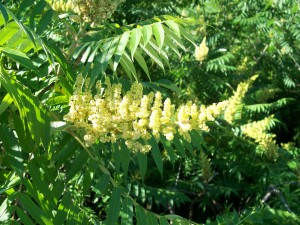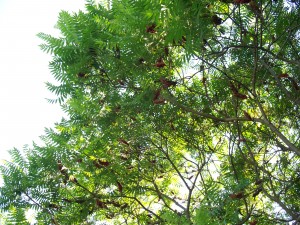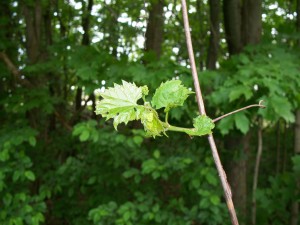Invasive Species
By Rich Finzer
One of the greatest strengths of any woodlot, forest or open stretch of ground is its biodiversity. The greater the variety of species, the less chance disease or insects will ravage the entire area. Ironically, biodiversity may also become a glaring weakness, particularly if land begins hosting invasive species. Here in Cayuga County, we’re plagued by several of these invaders and unfortunately we’re not alone. Many invasive plants range across wide swaths of the U.S. Of the time spent managing my woodlot, a good portion is devoted to eradicating these unwelcome and often alien pests.
Japanese honeysuckle (Lonicera japonica) is a perfect example. Introduced into the U.S. in 1806 to help combat soil erosion, no one anticipated how invasive the plant would become. On my farm, the shrubs proliferate where the cropland meets the edge of the woodlot. Every spring, while the ground is soft, I make a concerted effort to rip out as many as I can. Fortunately, the shallow rooted honeysuckle is easy to identify and easy to dislodge. [We had a hard time with the italics in this story and decided to just omit them. You know where they go. —Ed.]
The flowers, which occur in pairs, range in color from pure white to a creamy whitish-yellow. The ovate leaves are set opposite on the woody branches. Following pollination, each bloom produces a black berry containing a single seed. As birds eat the fruit, the seeds are deposited in their droppings, accounting for the speed with which the plant can overtake an area.
One of the other invasive trees I regularly confront is white mulberry (Morus alba). Native to China where it is used to feed silkworms, it was introduced during colonial times as our British masters tried to establish a fledgling silk industry. The trees produce a tart edible fruit about the size of a raspberry. Wild birds, especially robins and bluebirds consume them and deposit the seeds in their droppings. The plants are stubborn to remove, and even if cut off at the ground line will often re-sprout. While I like songbirds, I’m no fancier of white mulberry. The only sure-fire method I’ve found for completely killing one is cutting it flush with the ground and then auguring a hole into the center of the stump. Following that, I insert a funnel filled with bleach. Once the roots absorb the bleach, it’s curtains. [While this is undoubtedly an effective method, using bleach—or any substance not labeled an herbicide—to kill plants is actually illegal, and we therefore cannot recommend it. —Ed.]
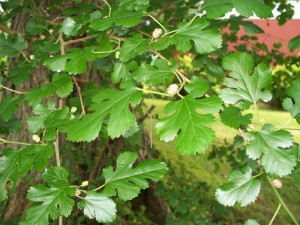
White mulberry with berries just beginning to ripen
Another invasive species is Russian olive (Elaeagnus angustifolia). Native to southern Europe, it was brought to the U. S. during the late 1800’s. Like other introduced alien plants, it too will quickly overtake native trees. Its leaves are slender, shiny on top and a fuzzy olive-gray underneath. The tree produces hundreds of tiny yellow flowers that bloom at the base of the leaves. Following pollination, each forms a small olive-colored fruit roughly the size of a chickpea. The plant prefers partial sun, and removing one can be nasty business, as the branches are armored with 1 to 3 inch thorns. If Russian olive has a sole redeeming quality, it’s that the thorns afford great protection to nesting birds, particularly catbirds. As a nod to my avian friends, if I encounter one, I generally spare it until nesting has concluded. I am not nearly as merciful with wild roses.
The wild or multiflora rose, (Rosa multiflora) is another challenging adversary native to China. Brought to the U.S. sometime during the 1700’s, the plant is covered with long, extremely sharp thorns, tough enough to pierce heavy leather work gloves. It proliferates by sending out runners, rooting its drooping canes to the soil and by seeds. According to some biologists, a single plant may produce as many as 17,000 seeds during a single growing season! If I locate a large one, I attach a cable noose around the main trunk and tear out the entire plant using my pickup. In Midwestern states like Ohio, wild rose is subject to massive state-sponsored eradication programs. According to USDA estimates, it infests as many as 45 million acres. How much land is that? It’s roughly the combined land area of New York and Connecticut. I don’t blame anybody for anything they do to eliminate this scourge. Have at it.

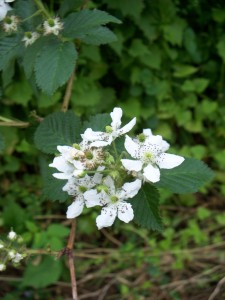
Roadside berm infested with multiflora rose; Multiflora rose blossoms
While many invasive plants were imported, one native species, staghorn sumac (Rhus typhina), is equally challenging to control. Classified as a woody shrub, sumacs are shallow rooted and spread by both rhizomes and seeds. After flowering, the familiar rusty-red, fruiting head begins forming. It’s actually a compact cluster of fruits known as drupes. Drupes measure 1/4 inch in diameter and contain one seed. Interestingly, the germination rate of sumac seeds is enhanced after passing through the digestive systems of rabbits. So if you’ve got lots of sumacs, you probably have a thriving bunny population too. Sumacs prefer sunny locations and are often the first trees to grow on abandoned farmland. The yellow 12-inch flower plumes emerge in early June. By late summer, the ripening drupes take on their trademark rusty-red hue. I’ve found the easiest method of destroying sumacs is tearing them out by the roots. For larger ones, I sometimes employ my truck and a length or two of logging chain.
Staghorn sumac flower plume; Reddish clusters of sumac drupes
Up until now, the plants I’ve described might be classified as troublesome or stubborn, but giant hogweed (Heracleum mantegazzianum) is justifiably described as vile. It’s extremely invasive and it’s extremely poisonous as well. It’s a phototoxic plant. When exposed to the UV rays in sunlight, the sap from the stalk is capable of burning exposed flesh (a condition known as phytophotodermatitis). If even a small amount of sap gets near your eyes, it may cause blindness! A mature plant can reach a height of 15 feet, and the main flower growing atop the stalk may attain a diameter of 30 inches. Giant hogweed is native to Central Asia, and was introduced into the U.S. during the early part of the twentieth century as an ornamental (what were those idiots thinking?). Classified by the USDA as a noxious weed, it is a perennial and once fully established is nearly impossible to eradicate. Regular mowing keeps it under some measure of control, but for total elimination only two methods are known. The main taproot must be severed about 6 inches below the ground or the plant must be killed chemically. Regrettably, giant hogweed prefers moist soils, particularly along stream banks and gullies, making it difficult to reach. Five summers ago, I discovered a lone plant growing along the bank of the creek bisecting my property. While wearing heavy gloves, heavy clothing and eye protection, I sprayed the entire plant with herbicide. After drenching the entire plant, it quickly perished. [The DEC instead cautions citizens to use only the manufacturer’s recommended dose. For more on controlling hogweed with herbicides, see dec.ny.gov/animals/40961.html. —Ed.] If you encounter a solitary plant as I did, you may be able to destroy it on your own. However, if a large colony develops, you may require the assistance of professionals with their arsenal of federally regulated herbicides. Either way, it must be killed wherever it’s found. The DEC has taken notice of giant hogweed too. Since 2008, a 14-person team regularly attacks and destroys the plants whenever/wherever its presence is reported. To report giant hogweed, contact the DEC’s Hogweed Hotline at 845-256-3111.

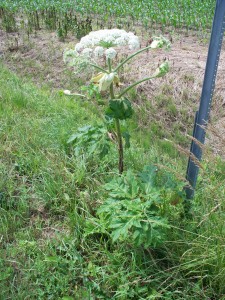
Giant hogweed plant over 6 feet tall
Rounding out the rogue’s gallery is another streamside pest, the wild grape (Vitis riparia). Also known as riverbank grape, it flourishes along creeks or streams. Growing to an ultimate height of 50 feet, this woody vine looks to surrounding trees for support, growing into the crowns until it smothers them. Found across the entire northern half of the U.S., it’s the bane of landowners everywhere. Small plants may be pulled out by the roots; larger specimens with their shaggy bark should be chopped off at the ground line and the woody vines pulled down.
The beauty of our woodlands, stream banks and fields is something too many folks take for granted. But responsible stewardship requires every landowner to rid their space of any invasive species they encounter. It’s hard work. It requires persistence, coupled with the enthusiasm of a fanatic; and it’s worth it.
Additional Information: Visit www.usda.gov or the individual websites listed below.
- Japanese honeysuckle: www.invasivespeciesinfo.gov/plants/honeysuckle.shtml
- Russian olive: www.invasivespeciesinfo.gov/plants/russolive.shtml
- White Mulberry: http://plants.usda.gov/plantguide/pdf/pg_moal.pdf
- Multiflora rose: http://www.pa.nrcs.usda.gov/programs/CREP/CREP_WS_2_ROSMU.4.27.07.pdf
- Staghorn sumac: http://plants.usda.gov/factsheet/pdf/fs_rhhi2.pdf
- Wild grape: http://plants.usda.gov/java/profile?symbol=VIRI
- Giant hogweed: http://www.dec.ny.gov/animals/39809.html
- Giant hogweed: http://www.9wsyr.com/mostpopular/story/Beware-the-giant-hogweed-agency-warns-NYS/QApZhBF4qEqWL5BPOFoTmg.cspx
Raised in Chili, NY, Rich Finzer resides on an 80-acre farm near Hannibal. He is a regular contributor to Living Aboard, Life in the Finger Lakes and Dollar Stretcher magazines.
Photos by Rich Finzer
Views: 0







